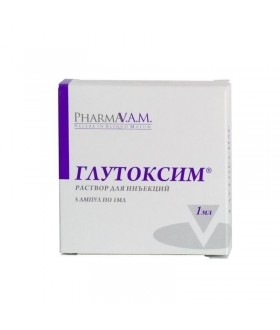




Security policy (edit with Customer reassurance module)

Delivery policy (edit with Customer reassurance module)

Return policy (edit with Customer reassurance module)
5 pieces
GLUTOXIM - immunomodulator with systemic cytoprotective action. It belongs to the class of thiopoietins. It has a modulating effect on the intracellular processes of thiol metabolism, which plays an important role in the regulation of genetic and metabolic processes in cells and tissues.
The mechanism of action is the regulation of redox cell reactions. A new level of redox systems and the dynamics of phosphorylation of key proteins of signal-transmitting systems and transcription factors (NFkB and AP-1), primarily immunocompetent cells, determines the immunomodulatory and systemic cytoprotective effect of the drug.
The drug has a differentiated effect on normal and transformed cells. In normal cells, Glutoxim stimulates the processes of proliferation and differentiation, in transformed cells it induces apoptosis (genetically programmed cell death).
The drug has a high tropism for the cells of the central organs of immunological protection and lymphoid tissue, enhances bone marrow hematopoiesis (erythropoiesis, lymphopoiesis, granulocytopoiesis, monocytopoiesis), activates phagocytosis, including in conditions of immunodeficiency. Restores the level of neutrophils, monocytes, lymphocytes and functional activity of macrophages in peripheral blood.
The drug has a stimulating effect on the cascade mechanisms of phosphate modification of key proteins of the signal-transmitting systems, the initiation of the cytokine system (including endogenous production of IL-1, IL-6, TNF, IFN), erythropoietin, reproduction of the effects of IL-2 through its expression receptors. - immunomodulator with systemic cytoprotective action. It belongs to the class of thiopoietins. It has a modulating effect on the intracellular processes of thiol metabolism, which plays an important role in the regulation of genetic and metabolic processes in cells and tissues.
The mechanism of action is the regulation of redox cell reactions. A new level of redox systems and the dynamics of phosphorylation of key proteins of signal-transmitting systems and transcription factors (NFkB and AP-1), primarily immunocompetent cells, determines the immunomodulatory and systemic cytoprotective effect of the drug.
The drug has a differentiated effect on normal and transformed cells. In normal cells, Glutoxim stimulates the processes of proliferation and differentiation, in transformed cells it induces apoptosis (genetically programmed cell death).
The drug has a high tropism for the cells of the central organs of immunological protection and lymphoid tissue, enhances bone marrow hematopoiesis (erythropoiesis, lymphopoiesis, granulocytopoiesis, monocytopoiesis), activates phagocytosis, including in conditions of immunodeficiency. Restores the level of neutrophils, monocytes, lymphocytes and functional activity of macrophages in peripheral blood.
The drug has a stimulating effect on the cascade mechanisms of phosphate modification of key proteins of the signal-transmitting systems, the initiation of the cytokine system (including endogenous production of IL-1, IL-6, TNF, IFN), erythropoietin, reproduction of the effects of IL-2 through its expression receptors.
Prevention and treatment of secondary immunodeficiency states associated with radiation, chemical and infectious factors;
Restoration of suppressed immune reactions and depression of bone marrow hematopoiesis;
Increasing the body's resistance to various influences (infection, intoxication, radiation);
As a hepatoprotective agent for acute and chronic hepatitis B and C, with the elimination of the objective signs of chronic virus-carrying;
Potentiation of therapeutic effects of antibiotic therapy of chronic obstructive pulmonary diseases;
Severe, common forms of tuberculosis of various localization (as part of complex therapy);
Drug-resistant tuberculosis;
Treatment of toxic complications of anti-tuberculosis therapy;
Diseases of the genitourinary system (chronic pyelonephritis, glomerulonephritis);
Prevention of postoperative purulent complications.
Pregnancy;
Lactation (breastfeeding);
Hypersensitivity to the drug.
For adults the drug is administered in /, in / m and s / c in a dose of 5-40 mg daily, depending on the severity of the disease. Course dose - 50-300 mg.
With tuberculosis (as part of complex therapy) the drug is prescribed in / in or in the / m and 30 mg 2 times / day, daily for 2 months. After the transition of a specific inflammation into the productive phase, the drug is administered i / m at a daily dose of 10–20 mg 1–2 times / day (morning and evening) 3 times a week.
If necessary, conduct a second course of treatment after 1-6 months.
With the preventive purpose the drug is used in the / m dose of 5-10 mg daily for 10 days.
An isotonic solution of sodium chloride or 5% glucose solution should be used as a solvent.
Maybe: in some cases - an increase in body temperature (37.1-37.5 ° C), pain at the injection site (to reduce pain, it is possible to administer the drug simultaneously with 1-2 ml of a 0.5% solution of novocaine).
The drug should be stored in a dark place at a temperature not exceeding 25 ° C
Glutoxim